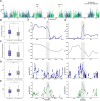Interploidy Introgression Shaped Adaptation during the Origin and Domestication History of Brassica napus
- PMID: 37707440
- PMCID: PMC10504873
- DOI: 10.1093/molbev/msad199
Interploidy Introgression Shaped Adaptation during the Origin and Domestication History of Brassica napus
Abstract
Polyploidy is recurrent across the tree of life and known as an evolutionary driving force in plant diversification and crop domestication. How polyploid plants adapt to various habitats has been a fundamental question that remained largely unanswered. Brassica napus is a major crop cultivated worldwide, resulting from allopolyploidy between unknown accessions of diploid B. rapa and B. oleracea. Here, we used whole-genome resequencing data of accessions representing the majority of morphotypes and ecotypes from the species B. rapa, B. oleracea, and B. napus to investigate the role of polyploidy during domestication. To do so, we first reconstructed the phylogenetic history of B. napus, which supported the hypothesis that the emergence of B. napus derived from the hybridization of European turnip of B. rapa and wild B. oleracea. These analyses also showed that morphotypes of swede and Siberian kale (used as vegetable and fodder) were domesticated before rapeseed (oil crop). We next observed that frequent interploidy introgressions from sympatric diploids were prominent throughout the domestication history of B. napus. Introgressed genomic regions were shown to increase the overall genetic diversity and tend to be localized in regions of high recombination. We detected numerous candidate adaptive introgressed regions and found evidence that some of the genes in these regions contributed to phenotypic diversification and adaptation of different morphotypes. Overall, our results shed light on the origin and domestication of B. napus and demonstrate interploidy introgression as an important mechanism that fuels rapid diversification in polyploid species.
Keywords: Brassica napus; Brassica; adaptive introgression; domestication; interploidy introgression; origin; polyploidy.
© The Author(s) 2023. Published by Oxford University Press on behalf of Society for Molecular Biology and Evolution.
Figures





References
-
- Arrigo N, Barker MS. 2012. Rarely successful polyploids and their legacy in plant genomes. Curr Opin Plant Biol. 15(2):140–146. - PubMed
Publication types
MeSH terms
LinkOut - more resources
Full Text Sources

